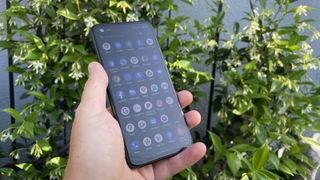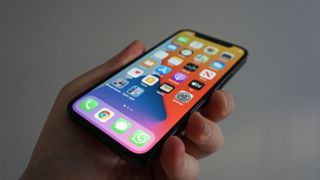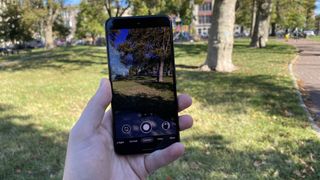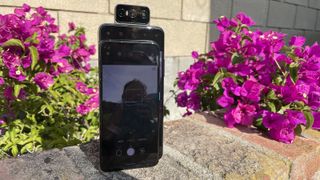Asus’ Zenfone 8 tests whether anyone wants small flagships instead of the full-sized Samsung S21
Will Zenfone 8 avoid the fate of the iPhone 12 mini and Pixel 5?

The launch of the 5.9-inch Asus Zenfone 8 will be a litmus test for whether or not phone buyers care about small, powerful phones – or whether Asus will regret withholding a plus-sized Zenfone 8 Pro.
Many of the best small phones, like the Google Pixel 4a and iPhone SE, offer mid-range specs to go with low prices for bargain shoppers. Anecdotally, some critics and consumers like these devices, but it’s not clear whether people buy these phones because they’re easier for one-handed browsing, they fit smaller hands, or simply because they’re more affordable.
Obviously, that’s a matter of preference. Different people will see their phone as a simple browsing and texting hub, a gaming powerhouse, a streaming display, or something else that requires more or less screen space. And folks with cartoonishly large or dainty hands will have different definitions of ‘one-handed’ phones.
But I suspect that most people choose cheap, one-handed phones for the price, and because large cheap phones can have underwhelming displays. Meanwhile, many buyers choose larger, expensive phones in part because Apple, Samsung and the rest reserve their best cameras and displays for the ‘Max’ or ‘Ultra’ handsets – not necessarily because of the mini-tablet size.
- Best phone 2021: the top 15 smartphones
- iPhone 13 release date, price and every important new iPhone leak
- The best cell phone deals for May 2021
That’s what makes the Zenfone 8 – with its powerful specs in a condensed, boring frame – such a rare bird. It doesn’t have a Pro or XL model, except for the novelty Zenfone 8 Flip that retains the flipping cameras but doesn’t upgrade much on last year’s model. We liked the Zenfone 7 Pro, but Asus evidently decided to push people towards its flagship and let more affluent buyers go for the 6.8-inch ROG Phone 5 instead.
Will a mid-range, one-handed phone stand out in a crowded smartphone market? Our reviewer was generally impressed by its quality, but by omitting last year’s flipping camera, Asus left the Zenfone 8 without many standout qualities besides its compact frame. And other similar phones arguably haven’t performed well in recent years.
Disappointing sales for other small flagships

One of Apple’s best-selling phones in recent years is the budget iPhone SE, of which Apple allegedly sold about 24 million units in 2020. It successfully cut into the cheap phone market that had previously been dominated by Android phones, the Samsung A series in particular.
Get daily insight, inspiration and deals in your inbox
Sign up for breaking news, reviews, opinion, top tech deals, and more.
Compared to that, the iPhone 12 mini – Techradar’s favorite small phone – reportedly accounted for just 5 percent of Apple smartphone sales in January 2021, according to Reuters. Apple had reportedly slashed its 12 mini production targets by ‘more than 70 percent’, Nikkei Asia reported in March.
In our iPhone 12 mini vs iPhone SE breakdown, we ruled strongly in favor of the mini for its display quality, performance, camera capabilities, 5G speeds and durability, though its lower battery capacity can be an issue. But more people are consistently buying the 4.7-inch SE than the more expensive 5.4-inch 12 mini.
Both are much smaller than the 5.9-inch Zenfone 8, but the 6-inch Google Pixel 5 and 5.8-inch Pixel 4a offer an even more appropriate case study. The Pixel 5 is a mid-range, one-handed flagship with a middling chipset and good point-and-shoot cameras; the Pixel 4a has a cheaper build, worse chipset, less RAM, disappointing battery life and other compromises to make it half the price as the Pixel 5.

We don’t have hard Pixel sales figures, but we do know that the downgraded Pixel 4a quickly sold out at launch; we also learned from Nikkei Asia that Google’s internal estimates suggested it would sell just 800,000 Pixel 5 phones, compared to about 2 million Pixel 4a and Pixel 4a 5G units.
Plus, back in 2019, Google was apparently very disappointed by its Pixel 4 sales numbers – around 2 million in its first six months – while it sold upwards of 7 million Pixel 3a units, per Android Authority. Again, the bargain phone triumphed while the mid-range, 5.7-inch flagship flopped by comparison.
Overall, flagship phone displays these days tend to be at least 6.1 inches (iPhone 12) or 6.2 inches (Galaxy S21), with Pro, Plus or Max displays trending about a quarter- or half-inch larger. Aside from the iPhone 12 mini, most manufacturers aren’t making compact flagships, only downgraded models with different names.
Sony used to reliably release a Compact version of its best Xperia every year, but stopped with the Xperia XZ2 Compact in 2018, while the rumored 2021 Sony Xperia Compact turned out to not be real.
Will the Zenfone 8 buck the trend?

Generally speaking, phone industry data provider Counterpoint found that small phone sales numbers have consistently dropped over the past couple of years (via Reuters). Phones under 6 inches represented 50 percent of sales at the end of 2018. By December 2020, that number was just 10 percent.
That doesn’t necessarily mean people don’t like small phones! We know that recent chip shortages have limited how many phones that companies can manufacture; in fact, Google will supposedly limit the number of Pixel 5a phones it sells in order to save more chips for the Pixel 6. It could just be that companies are prioritizing massive phones that turn a greater profit until more chips become available again.
That’s why I respect Asus’ plan to sell just one reasonably-sized flagship (the novelty Flip aside), instead of cannibalizing its sales figures with a cheaper downgrade or a larger Pro version. It will be a useful test to see if small phones still have a place in the $500+ smartphone market.
Personally, I have a variety of phones for work and personal use, from a 5.6-inch Pixel to a 6.5-inch OnePlus. As an avid gamer, I generally prefer laying down with a larger screen so I’m not straining my eyes. At the same time, I’m currently reckoning with my steadily worsening carpal tunnel syndrome, and find myself preferring to hold a narrow phone that doesn’t strain my hand and wrist for daily use.
The Zenfone 8 hits that sweet spot for buyers who want a new, affordable phone with great specs in an easy-to-hold package, without any FOMO for a Pro version that’s too big and expensive but gives you better performance.
I’m just curious how many other folks besides myself find that particular blend of qualities appealing enough to buy it – and in numbers that convince phonemakers to keep trying out new small-format devices.
Michael Hicks began his freelance writing career with TechRadar in 2016, covering emerging tech like VR and self-driving cars. Nowadays, he works as a staff editor for Android Central, but still writes occasional TR reviews, how-tos and explainers on phones, tablets, smart home devices, and other tech.
